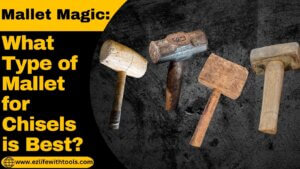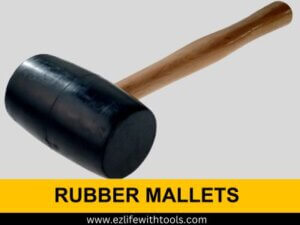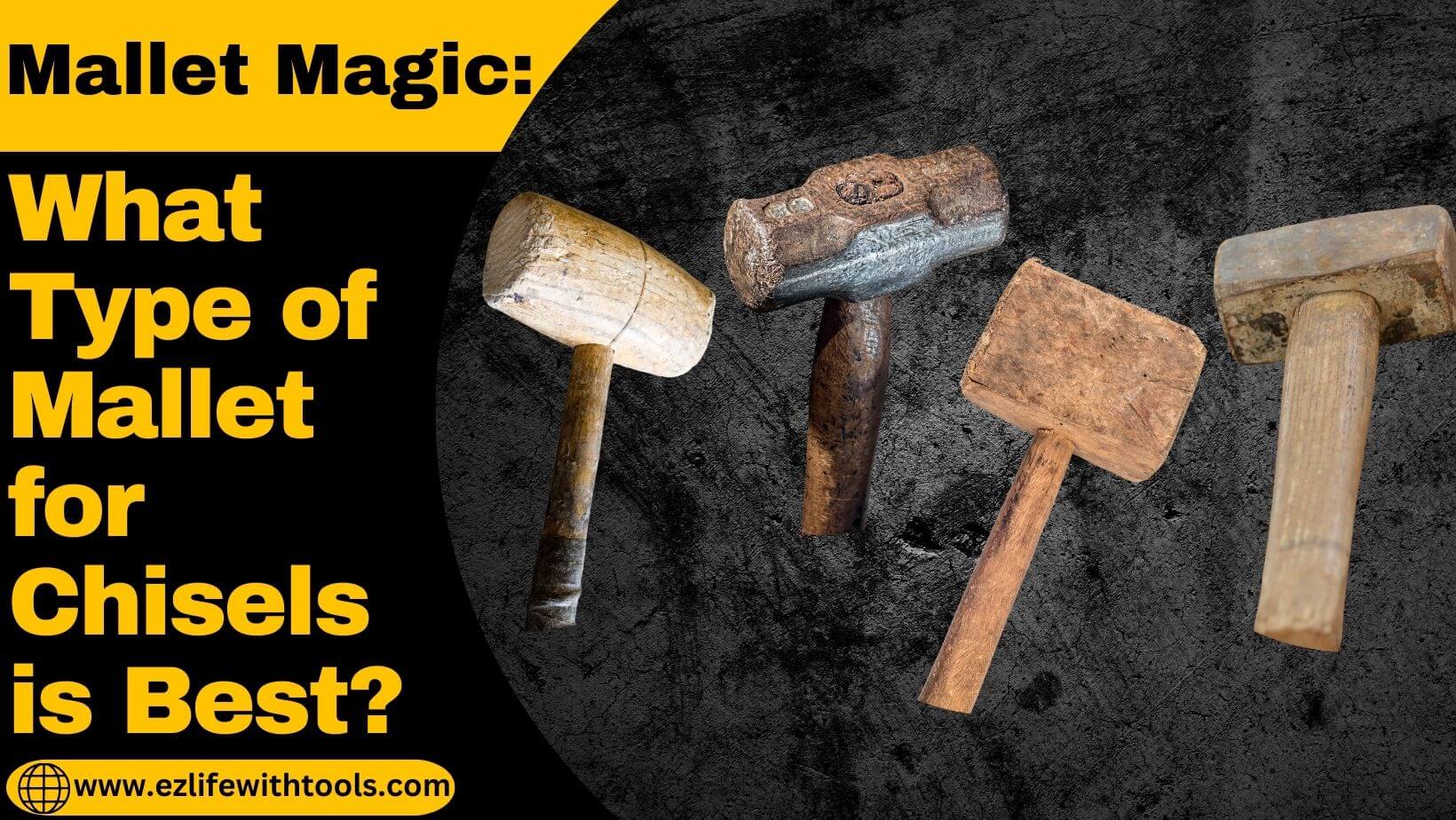Mallet Magic: What Type of Mallet for Chisels is Best?
Woodworking is not only an art or skill but can also be someone’s hobby or passion. But this passion or

hobby must demand precision, skill and the right set of tools.
Among those tool sets, chisels stand out as essential tools for carving, shaping and detailing wood.
However, the effectiveness of a chisel is not determined by the chisel alone; the type of malt used is also essential.
So, choosing the right mallet isn’t just a selection but a deciding factor that affects your tools’ accuracy, performance, and longevity.
In this article, we will explain what type of mallet for chisels is best, along with its importance, selection factors, and many essential tips.
So, keep reading.
Impact of Using the Wrong Mallet
Selection of an appropriate mallet for your chisels is not just a preference because it directly influences the outcome of your woodworking projects.
The wrong mallet can compromise the accuracy and precision of your chisel work.
A too-heavy or too-light mallet may cause uneven cuts or worse damage due to overstriking or insufficient force.
Here are some worse damages.
Using an incorrect mallet can cause wear and tear on your chisels.
The repeated impact of an incompatible mallet may cause the chisel’s edge to dull quickly.
You will need more frequent sharpening of the chisel.
The wrong mallet choice can slow down your progress.
Why is a Mallet Essential for Chisel Work?
It is a right question why a mallet is necessary for chisel work. Let’s explain it.
Distribution of Controlled Force
Chisels rely on manual force to cut wood, and mallets have the ability to provide a controlled and concentrated force to hit the chisel with precision and accuracy. This control force is vital for delicate tasks where precision is required.
Reduction of Hand Fatigue
It becomes especially relevant during long woodworking sessions because continuously hitting the chisel can directly affect your hands and wrists.
Using a mallet helps distribute the force required to chisel, reducing the stress on your hands and wrists and increasing both comfort and safety.
Minimal Risk of Injury
Hand-guided strikes reduce the risk of injury compared to using more hand force or trying to hit the chisel with other tools. A mallet allows you to apply the necessary force without damaging your hand.
What Type of Mallet for Chisels is Best?
Types of Mallets
There are many types of mallets in the market according to materials, and each type of mallet brings its own set of characteristics to the woodworking, which affect the chisels and, ultimately, the results of your projects.
- Wooden Mallets
- Rubber Mallets
- Dead Blow Mallets / Hammer
- Metal Mallets
1- Wooden Mallets
Wooden mallets are light, providing excellent control over strikes, and ideal for delicate chisel work, like carving intricate details or shaping softwood.
It can absorb the shock and reduce the stress on your hands and wrists and the chances of damage to the sharp end of the chisel.
But Over time, wooden mallets can develop dents or defects, and they may require occasional sanding or maintenance to keep the featured face in top condition.

2- Rubber Mallets
Rubber mallets feature a rubber or soft plastic striking face, providing an invisible surface, Ideal for tasks requiring a gentle touch.
They are lightweight and easy to handle and control. Rubber mallets are less likely to damage the chisel or workpiece.

3- Dead Blow Mallets / Hammer
Dead blow mallets have a cavity filled with shot or sand, which reduces bounce at impact to provide a controlled strike with less recoil, increasing accuracy.
Dead blow mallets are available in various weights, allowing for versatility in woodworking.
They are an Ideal choice for projects where constant force without excessive rebound is required, like joining or working with delicate materials.

4- Metal Mallets
Metal mallets are less common in woodworking because of their heavy weight and ability to damage chisels. Some metal mallets can change faces to reduce damage.
It is mainly used in metalwork and is suitable for applications where heavy impact force is required and potential damage to the chisel is acceptable.

Factors to Consider When Choosing a Mallet for Chisels
Many factors impact the results. Consider these factors to choose the right mallet for chisel work to ensure optimal performance.
- Material
- Weight
- Handle Design
1- Material
You have already learned about each type of mallet according to the material. Consider these factors if you are choosing a mallet according to the material.
Wooden Mallets
It provides a softer striking surface, reducing the risk of damaging the chisel or marring the workpiece and is suitable for delicate tasks and softer woods.
Rubber Mallets
A non-marring surface minimizes the potential for damage to both the chisel and workpiece and is Ideal for tasks requiring a softer touch.
Dead Blow Mallets
The filling inside dead blow mallets absorbs some of the impact, protecting the chisel and workpiece, and is suitable for various woodworking applications.
Metal Mallets
It can potentially damage chisels and workpieces due to their heavier and harder striking surface. It is used limited in woodworking and more common in metalworking.
2- Weight
Weight consideration is also essential when choosing the mallet.
Lightweight Mallets
It offers better control for delicate tasks and precision work.
It reduces hand and wrist fatigue during prolonged use.
Heavier Mallets
Provides more striking force.
It is suitable for heavier chisels or tasks that require greater impact.
It may be challenging to control for finer work.
Varied Weights in Dead Blow Mallets
The availability of dead blow mallets in different weights allows for versatility in woodworking tasks.
3- Handle Design
The handle is an integral part of the mallet. Without a handle, it is useless. So, you must pay attention to its importance.
Handle design not only contributes to overall control and precision but also minimizes hand fatigue during use. Its design may vary but may have rubber or other grips for better ergonomics. So, choose one according to your preferences.
Best Type of Mallet for Chisel Work
After a lengthy discussion and analysis, it is true that, when it comes to choosing a mallet for your chisel work, I find that wooden mallets stand out as a versatile and preferred choice.
Because of their balanced weight, light surface, and ergonomic design make them ideal for controlled and precise attacks.
Wooden mallets provide the required force without damaging the integrity of the chisel or workpiece.
Whether you’re carving intricate details or shaping softwood, the simplicity and effectiveness of a wood mallet make it the perfect choice for many woodworking tasks.
Conclusion
The right selection of mallets for chisels is essential to achieve excellent results. The mallet choice significantly influences your projects’ precision, control, and overall success.
Tailor your tool selection to the unique demands of each project and understand the characteristics of different mallets and chisels to make informed decisions.
If you have reached these lines, you have understood what type of chisel mallet is better.
Thank you for your interest and trust.
Best wishes
Frequently Asked Questions
Can you use a rubber mallet with chisels?
Yes, you can use it only with limited force for carving or shaping tasks to prevent the chisel and workpiece from damaging.
How many types of mallets are there?
There are many types of mallets in the market according to materials.
1- Wooden Mallets
2- Rubber Mallets
3- Dead Blow Mallets / Hammer
4- Metal Mallets
What is the difference between rubber mallet and wooden mallet?
There is not a big difference in both. Rubber mallet has soft rubber head for delicate work, while wooden mallet has wooden head for heavier tasks.
Why use a wooden mallet?
It is commonly used in woodworking projects because it provides a non-damaging impact for driving chisels and assembling joints.

